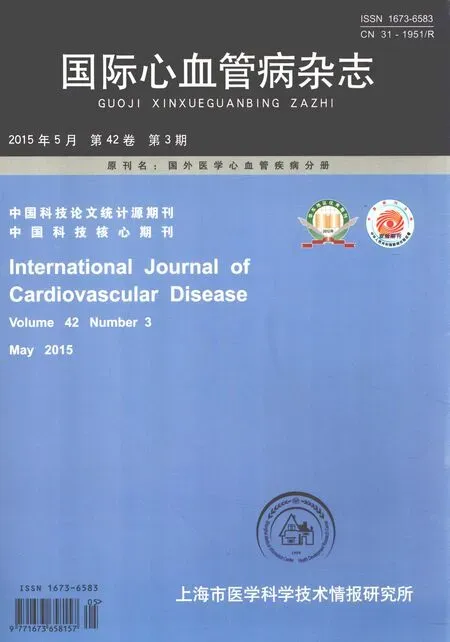急性主动脉综合征研究进展
葛永彬
1998年Vilacosta等[1]首次提出急性主动脉综合征(acute aortic syndrome,AAS)的概念。2001年他们将AAS正式定义为主动脉夹层(aortic dissection,AD)、主动脉壁间血肿(intramural haematoma,IMH)和穿透性主动脉粥样硬化性溃疡(penetrating atheroscleroticulcer,PAU)[2]。AAS起病急、死亡率高,易被漏诊和误诊,近年来备受关注[3]。
1 流行病学
牛津血管病研究显示,AD在自然人群中的发病率约为每年6/10万,男性多于女性[4]。冠状动脉造影导致的AD发病率<0.4‰;经皮冠状动脉介入治疗导致的AD发病率约1‰[5-6],亦有文献报道经皮冠状动脉介入治疗导致的AD发病率高达7.5‰[7]。IMH 发病率约占 AAS的10%~25%,发病部位依次为升主动脉(30%)、主动脉弓(10%)、降主动脉(60%~70%)。PAU仅占AAS的2%~7%,绝大多数病变位于降主动脉(>90%),较少发生在主动脉弓或腹主动脉,极少累及升主动脉。
2 病理生理学和分型
AAS初始时内膜发生溃疡或撕裂,主动脉腔内的血液通过内膜破口进入主动脉中膜或主动脉滋养血管自发破裂而在中膜出血,导致炎症反应,使主动脉扩张和破裂。
AD常累及升主动脉近端和左锁骨下动脉开口远端降主动脉[8]。根据主动脉受累范围和内膜破裂口位置,目前有DeBakey和Stanford两种分型。DeBakeyⅠ型破口位于升主动脉,累及主动脉弓或更远;Ⅱ型局限于升主动脉;Ⅲ型起自降主动脉并常向远端扩展,罕有逆行累及主动脉弓。Stanford A型病变累及升主动脉,伴或不伴降主动脉病变(相当于DeBakeyⅠ和Ⅱ型);B型累及降主动脉(相当于DeBakeyⅢ型)。按内膜撕裂形式又可分为5型,即1型:经典AD,包含真腔和假腔;2型:IMH;3型:主动脉壁膨胀导致的微小AD;4型:PAU;5型:医源性或创伤性 AD[9]。
3 危险因素
AD的危险因素包括:(1)主动脉壁压力增高:高血压,尤其是中、重度高血压和继发性高血压(如嗜铬细胞瘤),吸食可卡因、举重、遭受外伤或车祸引起突发扭转或减速导致的损伤[10-11];(2)主动脉中膜异常:遗传性疾病如马凡综合征、家族性胸主动脉瘤、炎症性血管炎如大动脉炎和巨细胞性动脉炎;(3)妊娠、多囊肾等[11-15]。IMH 进展预测因子包括:顽固性高血压、经积极治疗后仍有胸痛症状、主动脉内径≥50 mm,主动脉壁厚度>11 mm等[16-18]。PAU 的危险因素包括:高龄、吸烟、男性、高血压、冠心病、慢性阻塞性肺病、腹主动脉瘤等[19-20]。
4 临床表现和并发症
疼痛是AAS最典型的临床症状,常表现为突发剧烈胸痛或背痛,呈撕裂或刀割样,部分患者可出现腹痛或腰痛以及四肢脉搏异常[21]。10%~15%的患者伴有主动脉瓣反流、心包填塞、继发性心肌缺血甚至心肌梗死;少见咯血、呼吸困难等肺部症状;神经系统症状表现为声音嘶哑、急性偏瘫;部分患者可发生胰腺炎或急性肾功能异常;肠系膜动脉缺血的发生率<5%,可表现为腹痛[22]。
5 诊断
结合患者的危险因素、临床表现、实验室以及影像学检查结果,综合诊断AAS。
5.1 实验室检查
D-二聚体(D-dimer,DD)胶乳凝集法(阴性<0.5 mg/L)对 AD 的敏感性达 100%,特异性为67%[23]。在AD发生1 h时,DD即迅速升高,具有很高的鉴别诊断价值[24]。C-反应蛋白(CRP)在 AD发病后即升高,尤其在伴有低氧血症、胸腔积液的患者中升高更为明显,CRP可作为危险程度评估的参考指标[25-26]。主动脉内壁损伤可导致生物标志物释放入血,平滑肌肌球蛋白重链(smooth muscle myosin heavy chain,smMHC)、基质金属蛋白酶-8(matrix metalloproteinase-8,MMP-8)、可溶性弹性蛋白片段(soluble elastin fragments,sELAF)和腱糖蛋白C(tenascin-C,TN-C)均可提供诊断线索,但目前尚在实验阶段,未进入临床实践[27-30]。
5.2 影像学检查
目前临床上常用的筛查手段有经胸超声心动图(transthoracic echocardiography,TTE)、计算机X线断层成像(computed tomography,CT)和核磁共振成像(magnetic resonance imaging,MRI)[31]。
TTE对升主动脉病变的敏感性为59%~83%,特异性为63%~93%,对主动脉远端病变的敏感性约为70%,对心脏并发症如主动脉瓣关闭不全、心包填塞等诊断亦有参考价值。TTE对IMH的敏感性<40%。
CT平扫可发现主动脉管腔扩张,钙化内膜向腔内移位,当移位超过5 mm有诊断意义。CT平扫还可显示心包积液、胸腔积液或纵隔血肿等一些间接征象,但不具有特异性。增强CT可清晰显示内膜片将主动脉管腔分为真腔和假腔,较好地显示夹层,还可判断假腔内是否存在血栓及分支血管受累,其准确性高达87%~94%。目前门急诊主要采用多层螺旋CT,尤其是64层CT心电门控技术可以消除心脏搏动伪影,具有高时间、空间分辨率,敏感性、特异性及阴性预测率均接近100%,已成为AD的一线影像学检查手段。CT诊断IMH的影像学特征主要表现为增厚的新月形或环形主动脉壁内高密度影,其敏感度高达100%,可作为首选的诊断方法[32]。
MRI诊断AD的敏感性和特异性均为98%,自旋回波黑血序列(spin-echo black-blood sequences)可以清晰显示内膜片,并通过管腔内信号特征鉴别真腔和假腔,还可检测心包积液、主动脉瓣反流、颈动脉夹层等并发症。MRI能较好地识别IMH病理学改变,并有助于评估血肿消退或进展。然而,MRI有一定局限性,其成像时间长,不适合病情危重的急诊患者以及置入起搏器、金属异物(钛合金除外)的患者[33-34]。
6 治疗原则
AAS的治疗目标是预防夹层进展和致死性并发症。若病变累及升主动脉(A型病变),可考虑外科手术。若累及降主动脉(B型病变),除外夹层迅速扩展、疼痛难以控制、主要器官或肢体灌注不良等,原则上先予以药物治疗。药物治疗以缓解疼痛、降低左室心肌收缩力和血流对主动脉壁的剪切力为主,首要目标是控制收缩压到正常低限值(100~120 mmHg)和控制心率(<60次/min)。
6.1 AD
A型AD患者建议行急诊手术治疗,主要针对升主动脉内膜撕裂处的血管置换和主动脉根部及主动脉瓣的修补。针对IRAD注册登记的936例A型AD患者(年龄最大80岁)的研究结果显示,手术干预的患者院内死亡率明显低于药物治疗患者[35]。目前主动脉弓部病变处理仍存在较大争议,外科手术结合腔内隔绝术可能是今后治疗方向之一。
非复杂B型AD以药物治疗为主,首选β受体阻滞剂。复杂B型AD推荐行胸主动脉腔内修复术(thoracic endovascular aortic repair,TEVER)[36]。这类患者的病变复杂性表现在:经积极内科治疗后仍存在反复或持续性疼痛,积极降压治疗后血压仍难以控制,重要脏器或肢体缺血,有主动脉破裂征象(血胸、进行性主动脉直径和纵隔血肿增大)。外科手术病死率和并发症发生率较高,属于次选治疗方法,目前大多已被血管内介入治疗技术替代。
6.2 IMH和PAU
IMH和PAU的治疗目的是防止主动脉破裂和进展为AD,处理原则同AD。A型IMH手术指征包括:24 h内新发病变,伴有心包积液、腹主动脉血肿和大动脉瘤等。而对于主动脉直径<50 mm、IMH厚度<11 mm的高龄A型IMH患者,目前主张药物治疗和影像学(CT或MRI)密切监测。若PAU病变直径>20 mm、深度>10 mm,应尽早行干预治疗。
7 预后
未经治疗的AD患者预后极差,院外死亡率达25%,发病48 h内每小时病死率可增加1.4%,死亡率高达68%。经手术干预的AD患者术后1个月内死亡率可从90%降至30%。A型AD患者最初48 h内死亡率为50%,围手术期死亡率为25%,神经系统并发症发生率为18%;B型AD患者术后院内死亡率为25%~50%,手术相关并发症包括脊髓缺血 (6.8%)、卒 中 (9%)、肠 系 膜 缺 血 或 栓 塞(4.9%)、急性肾功能衰竭(19%);接受 TEVAR 治疗的患者30 d内死亡率仅为8%,卒中和脊髓缺血发生率分别为8%和2%[37]。
有研究显示,IMH患者的5年存活率为43%~90%,A型IMH出现症状者前8 d内30%~40%可进展为AD,B型IMH院内死亡率<10%。
PAU预后复杂,可演变为假性动脉瘤、IMH,甚至AD、主动脉破裂。
[1]Vilacosta I,San Román JA,Aragoncillo P,et al.Penetrating atherosclerotic aortic ulcer: documentation by transesophageal echocardiography[J].J Am Coll Cardiol,1998,32(1):83-89.
[2]Vilacosta I,Román JA.Acute aortic syndrome[J].Heart,2001,85(4):365-368.
[3]Hiratzka LF,Bakris GL,Beckman JA,et al.2010 ACCF/AHA/AATS/ACR/ASA/SCA/SCAI/SIR/STS/SVM Guidelines for the diagnosis and management of patients with thoracic aortic disease.A Report of the American College of Cardiology Foundation/American Heart Association Task Force on Practice Guidelines, American Association for Thoracic Surgery,American College of Radiology,American Stroke Association, Society of Cardiovascular Anesthesiologists,Society for Cardiovascular Angiography and Interventions,Society of Interventional Radiology,Society of Thoracic Surgeons,and Society for Vascular Medicine[J].J Am Coll Cardiol,2010,55(14):e27-e129.
[4]Howard DP,Banerjee A,Fairhead JF,et al.Population-based study of incidence and outcome of acute aortic dissection and premorbid risk factor control:10-year results from the Oxford Vascular Study[J].Circulation,2013,127(20):2031-2037.
[5]Gómez-Moreno S,Sabaté M,Jiménez-Quevedo P,et al.Iatrogenic dissection of the ascending aorta following heart catheterisation:incidence,management and outcome[J].EuroIntervention,2006,2(2):197-202.
[6]Leontyev S,Borger MA,Legare JF,et al.Iatrogenic type A aortic dissection during cardiac procedures:early and late outcome in 48 patients[J].Eur J Cardiothorac Surg,2012,41(3):641-646.
[7]Zidi M,Nallet O,Esteve JB,et al.Extensive iatrogenic coronary dissection during coronary angioplasty:a series of 19 consecutive patients[J].Ann Cardiol Angeiol (Paris),2010,59(5):306-310.
[8]McMahon MA,Squirrell CA.Multidetector CT of Aortic Dissection:A Pictorial Review[J].Radiographics,2010,30(2):445-460.
[9]Sampson UK,Norman PE,Fowkes FG,et al.Global and regional burden of aortic dissection and aneurysms:mortality trends in 21 world regions,1990 to 2010[J].Glob Heart,2014,9(1):171-180.e10.
[10]Vilacosta I,Aragoncillo P,Cañadas V,et al.Acute aortic syndrome:a new look at an old conundrum[J].Postgrad Med J,2010,86(1011):52-61.
[11]Nienaber CA,Powell JT.Management of acute aortic syndromes[J].Eur Heart J,2012,33(1):26-35b.
[12]Januzzi JL,Isselbacher EM,Fattori R,et al.Characterizing the young patient with aortic dissection:results from the International Registry of Aortic Dissection(IRAD)[J].J Am Coll Cardiol,2004,43(4):665-669.
[13]Regalado ES,Guo DC,Villamizar C,et al.Exome sequencing identifies SMAD3 mutations as a cause of familial thoracic aortic aneurysm and dissection with intracranial and other arterial aneurysms[J].Circ Res,2011,109(6):680-686.
[14]Immer FF,Bansi AG,Immer-Bansi AS,et al.Aortic dissection in pregnancy:analysis of risk factors and outcome[J].Ann Thorac Surg,2003,76(1):309-314.
[15]Adeola T,Adeleye O,Potts JL,et al.Thoracic aortic dissection in a patient with autosomal dominant polycystic kidney disease[J].J Natl Med Assoc,2001,93(7-8):282-287.
[16]von Kodolitsch Y,Csösz SK,Koschyk DH,et al.Intramural hematoma of the aorta:predictors of progression to dissection and rupture[J].Circulation,2003,107(8):1158-1163.
[17]Evangelista A,Dominguez R,Sebastia C,et al.Prognostic value of clinical and morphologic findings in short-term evolution of aortic intramural haematoma. Therapeutic implications[J].Eur Heart J,2004,25(1):81-87.
[18]Song JM,Kim HS,Song JK,et al.Usefulness of the initial noninvasive imaging study to predict the adverse outcomes in the medical treatment of acute type A aortic intramural hematoma[J].Circulation,2003,108 Suppl 1:II324-II328.
[19]Cho KR,Stanson AW,Potter DD,et al.Penetrating atherosclerotic ulcer of the descending thoracic aorta and arch[J].J Thorac Cardiovasc Surg,2004,127(5):1393-1399.
[20]Troxler M,Mavor AI,Homer-Vanniasinkam S.Penetrating atherosclerotic ulcers of the aorta[J].Br J Surg,2001,88(9):1169-1177.
[21]苏存华,谈梦伟,陆方林,等.268例急性A型主动脉夹层临床资料分析[J].国际心血管病杂志,2013,40(3):189-191.
[22]Di Eusanio M,Trimarchi S,Patel HJ,et al.Clinical presentation, management,and short-term outcome of patients with type A acute dissection complicated by mesenteric malperfusion:observations from the International Registry of Acute Aortic Dissection[J].J Thorac Cardiovasc Surg,2013,145(2):385-390.e1.
[23]Wen D,Du X,Dong JZ,et al.Value of D-dimer and C reactive protein in predicting inhospital death in acute aortic dissection[J].Heart,2013,99(16):1192-1197.
[24]Rogers AM,Hermann LK,Booher AM,et al.Sensitivity of the aortic dissection detection risk score,a novel guidelinebased tool for identification of acute aortic dissection at initial presentation:results from the international registry of acute aortic dissection[J].Circulation,2011,123(20):2213-2218.
[25]Wen D,Zhou XL,Li JJ,et al.Biomarkers in aortic dissection[J].Clin Chim Acta,2011,412(9-10):688-695.
[26]Sakakura K,Kubo N,Ako J,et al.Peak C-reactive protein level predicts long-term outcomes in type B acute aortic dissection[J].Hypertension,2010,55(2):422-429.
[27]Suzuki T,Distante A,Eagle K.Biomarker-assisted diagnosis of acute aortic dissection:how far we have come and what to expect[J].Curr Opin Cardiol,2010,25(6):541-545.
[28]Giachino F,Loiacono M,Lucchiari M,et al.Rule out of acute aortic dissection with plasma matrix metalloproteinase 8 in the emergency department[J].Crit Care,2013,17(1):R33.
[29]Parthenakis F,Koutalas E,Patrianakos A,et al.Diagnosing acute aortic syndromes:the role of specific biochemical markers[J].Int J Cardiol,2010,145(1):3-8.
[30]Nozato T,Sato A,Hirose S,et al.Preliminary study of serum tenascin-C levels as a diagnostic or prognostic biomarker of type B acute aortic dissection[J].Int J Cardiol,2013,168(4):4267-4269.
[31]Erbel R,Aboyans V,Boileau C,et al.2014 ESC Guidelines on the diagnosis and treatment of aortic diseases:Document covering acute and chronic aortic diseases of the thoracic and abdominal aorta of the adult.The Task Force for the Diagnosis and Treatment of Aortic Diseases of the European Society of Cardiology(ESC)[J].Eur Heart J,2014,35(41):2873-2926.
[32]杨呈伟,李炯佾,苏华伟,等.多层螺旋CT血管成像诊断和随访主动脉壁内血肿及伴发病变[J].中国医学影像技术,2013,29(11):1833-1837.
[33]Chiu KW,Lakshminarayan R,Ettles DF.Acute aortic syndrome:CT findings[J].Clin Radiol,2013,68(7):741-748.
[34]Nienaber CA,Powell JT.Management of acute aortic syndromes[J].Eur Heart J,2012,33(1):26-35b.
[35]Trimarchi S,Eagle KA,Nienaber CA,et al.Role of age in acute type A aortic dissection outcome:report from the International Registry of Acute Aortic Dissection (IRAD)[J].J Thorac Cardiovasc Surg,2010,140(4):784-789.
[36]Grabenwöger M,Alfonso F,Bachet J,et al.Thoracic Endovascular Aortic Repair(TEVAR)for the treatment of aortic diseases:aposition statement from the European Association for Cardio-Thoracic Surgery (EACTS)and the European Society of Cardiology(ESC),in collaboration with the European Association of Percutaneous Cardiovascular Interventions(EAPCI)[J].Eur Heart J,2012,33(13):1558-1563.
[37]Heijmen RH,Thompson MM,Fattori R,et al.Valiant thoracic stent-graft deployed with the new captivia delivery system:procedural and 30-day results of the Valiant Captivia registry[J].J Endovasc Ther,2012,19(2):213-225.

